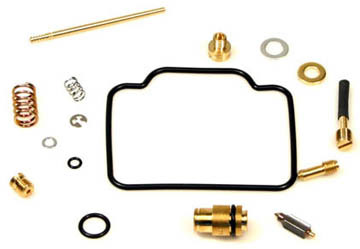Ask the Editors September 07 2011
Hello ATV Connection readers, welcome to our latest feature! Due to the rising popularity of the Ask the Editor forum, we have decided to expand the idea and post responses to the homepage.
For those of you who are new to this, basically, if you have an ATV related question, you can ask our editors for help/advice. Create a forum account if you don’t already have one, then create a new thread in our Ask the Editor section. It’s easy and fun!
And without further ado, here are this week’s questions.

Dear ATV Connection:
I’m on my third chain and sprockets for my YFZ450 in a little over 2-years. I want to upgrade to an o-ring chain and wonder if there will be noticeable loss in power. Also would making the move to an o-ring chain increase the life of the sprockets as well or just the chain?
While some increased drag is expected when switching from a traditional chain to a sealed o-ring unit, this coefficient will be unnoticeable to all but a very few individuals in tune with the distribution of power from each and every piston stroke. In other words, unless you are the world’s most fastidious professional racer/ tuner, don’t waste a moment fretting over power-loss concerns.
Indeed, assuming you put fresh sprockets on the machine at the same time you install the o-ring chain, you can expect increased sprocket life as the leading cause of wear stems from the lashing and tugging being administered by a worn (stretched) chain.

Dear ATVC:
I have a 1996 Suzuki King Quad that seems to have developed a most annoying habit of backfiring whenever I let off the gas. At first I was content to deal with the situation but my riding friends say it scares anyone riding behind me every time it happens. I really don’t want to take it into the shop because it otherwise runs great (tricky cold starting on occasion). Please help.
More than likely this exhaust pop experienced upon deceleration is a result of a lean condition in fuel metering. Fortunately, since your ATV is carbureted, the fix shouldn’t require enlisting the aid of a shop. The first place to target would be a little adjusting of the air/ fuel mixture screw on the carb. However, so as not to get yourself in trouble, turn this screw no more than 1 – 1.25 turns in either direction in your experimentation. If opening this screw (adding more fuel to the mixture) or closing it (subtracting fuel, hence increasing air) this much doesn’t alleviate the issue, or troubling still, worsens it, check the size of the main jet, which can also be responsible for difficult starting.
Replacing the main with a slightly larger unit usually alleviates the two conditions you describe, but again, remember that making alterations to the main jet also requires a corresponding tune of the air/ fuel mixture screw. You failed to mention whether or not your machine is still bone stock or has been modified in any way, but do keep in mind that simple modifications such as removing the lid on your ATV’s air box or switching to a freer flowing exhaust can affect the carburetion, just as you describe. In fact so can riding at elevation.
If you doubt your ability to diagnose such factors/ fixes, it’s not a bad idea to consider picking up a shop manual for your particular model. There is a wealth of information to be found there!

Dear ATVC:
I have a 1988 Yamaha Blaster with a full Toomy exhaust system. Trouble is I ride in a rock quarry and dented my beloved pipe pretty good. Is there an easy way to remove a dent from a 2-stroke pipe or do I have to buy a new one?
Well, the answer to that question really depends on your abilities as a mechanic. It’s rare for us to recommend seeking professional assistance over backyard tinkering, but because the following approach requires the use of a propane torch, it’s best to suggest taking the pipe to a qualified shop for the repair.
That said, the most common process involves using a propane torch to apply even-heat directly to the concaved area. With a bit of patience, most surface dents will slowly pop back. However if the pipe is badly mangled or broken through entirely (a common damage-area at the weld beneath the frame mounts), it may actually require cutting, re-shaping and then re-welding. Again this is why we usually play it safe and take our dented pipes to a qualified exhaust builder right from the get-go.
Do you have a question? Submit it by clicking here!
